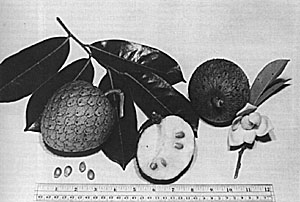From the book
Fruits of Warm Climates
by Julia F. Morton
Mountain Soursop
Annona montana Macf.
ANNONACEAE
Excerpt from the "Wild Custard Apple." Related Species.
The mountain soursop, A. montana Macf. (syns. A. Marcgravii Mart.; A. sphaerocarpa
Splitg.; A. Pisonis Mart.) is also called wild soursop, guanabana
cimarrona, guanabana de perro, guanabana de loma, corossol zombi;
corossolier batard, boszuurzak, araticum-ponhe and araticum de paca.

Fig. 25: The scarcely-edible mountain soursop (Annona montana)
It
grows wild from sea-level to 2, 000 ft (650 m) throughout the West
Indies and southward into Peru and Brazil, and is cultivated in the
Philippines and rarely in Florida.
The tree somewhat resembles
that of the soursop but has a more spreading crown and very glossy
leaves. It is slightly hardier and bears more or less continuously.
The
fruit is nearly round or broad-ovoid, to 6 in (15 cm) long. Its
dark-green skin is studded with numerous short, fleshy "spines". It
becomes very soft and falls when ripe. The pulp is yellow, peculiarly
aromatic, sour to subacid and bitter, fibrous, and contains many
light-brown, plump seeds. The quality is variable but generally very
poor. The fruit is generally regarded as inedible but is referred to as
"edible but mediocre" in Brazil. There, the firm core attached to the
base of the peduncle is pulled out and eaten as a tidbit.
In
southern Florida, exotic parrots eat the fruits and scatter the seeds,
and a few trees are consequently occurring as escapes. The tree is of
minor interest to horticulturists as an ornamental and rootstock. The
wood is soft, fibrous and useful only as fuel.
|
|